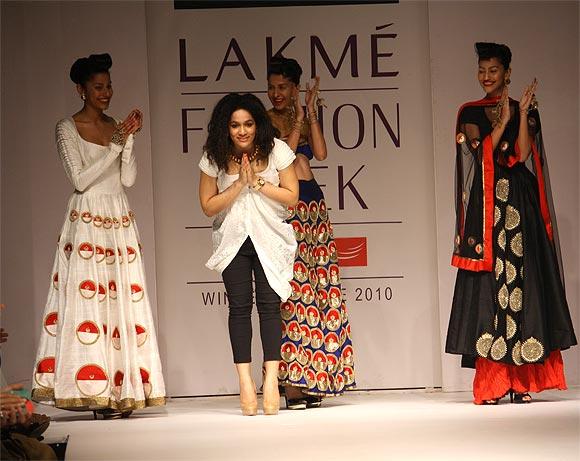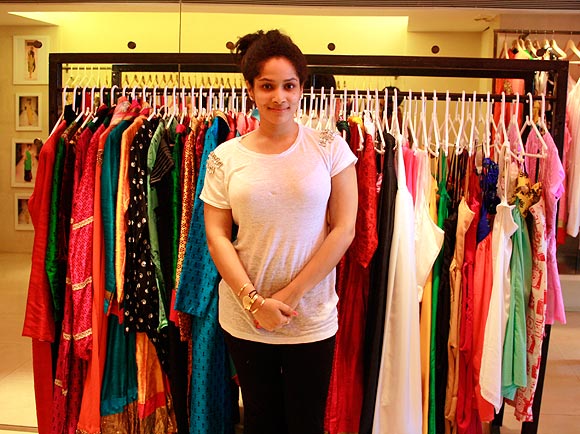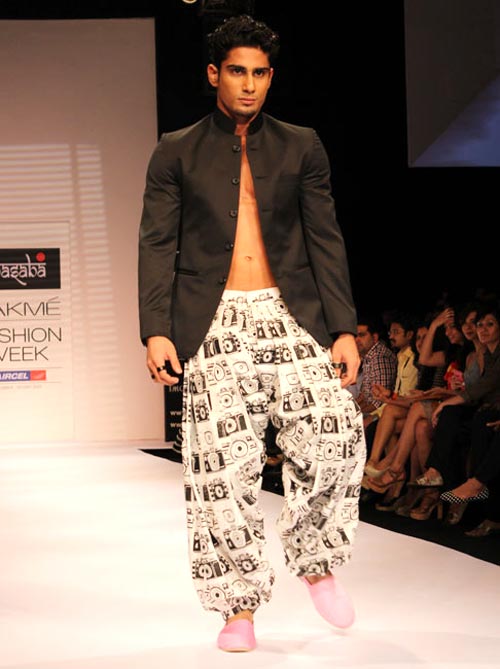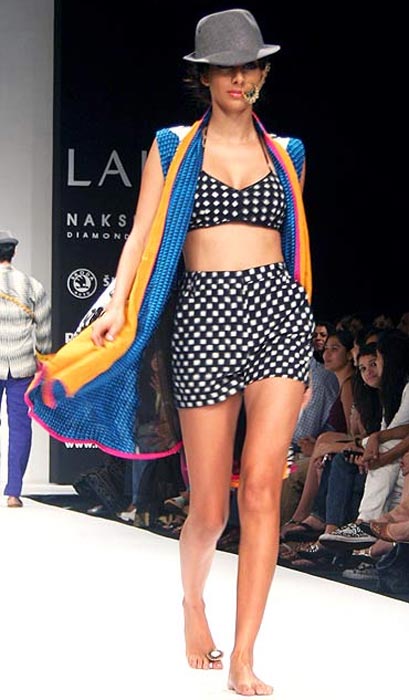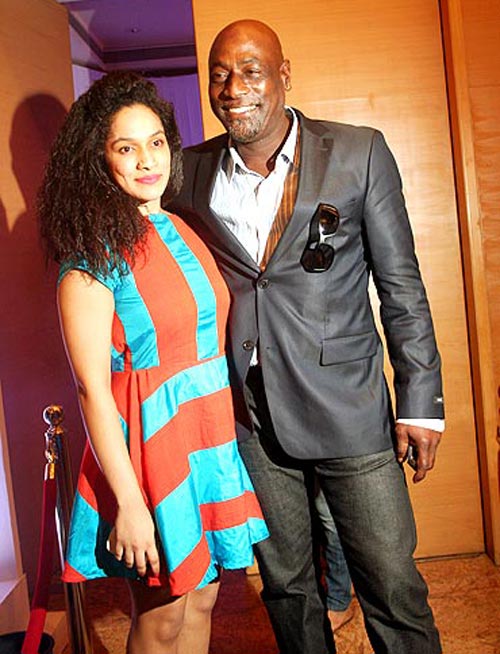 | « Back to article | Print this article |
Right now I am on a career high: Masaba Gupta
She made her debut as a GenNext designer when she was only 19. At 23 she has not only made a mark for herself as a fashion designer but has emerged as an entrepreneur to reckon with. The four years in between, says Masaba Gupta, have been wonderful for her.
In these four years she learnt the art of doing business even whilst stamping her own creative identity, maintaining a unique individuality through her designs, learning a bit of math and accounting, and, of course, how to make profits.
"Always listen to your gut feelings. They are always stronger than what you think they are and always prove right," she says when asked for her advice to young fashion designers who are struggling to make a mark in the industry. It is this gut feeling, she says, that helped her overcome the challenges she faced as a budding fashion designer-cum-entrepreneur.
With two stores -- in Mumbai and Delhi -- already under her belt that sell clothes under her eponymous brand, Masaba now has set her eyes on expansion and branding her designs to reach more Indian customers who she says wear her designs because they are modern and edgy and yet remind them of their Indian roots.
Masaba spoke with Prasanna D Zore about how she surmounted challenges, earned success as an entrepreneur, how she handles criticism when people attribute her debut to her famous parents and what upcoming designers should do to entrench themselves as successful fashion designers.
Tell us about your journey from being a college student to fashion designer...
I have been a big fluke to be pretty honest. I was in my second year of college when I started fashion week. I didn't want to be a fashion designer, cliched as this may sound, but I remember when I did my college graduation show, Wendell Rodricks had come.
When he saw my line he said just give it a shot, just send in two pieces from this line to apply. I sent it and I got through; so I was there (at the GenNext show in 2009). I hadn't even completed my internship, which I am supposed to, as part of my diploma. But fashion designing literally happened to me by fluke and I didn't even know if I wanted to do it until I was a part of the GenNext.
When I saw the response to my line I realised it was really working for me. So yes, I was really a big fluke.
The time you sold your first design...
After our college show we had two-day sale at Kimaya (a fashion store in Mumbai that sells lines from various designers) because Kimaya was the sponsor of our college show. And that's the time my first sari sold there. It was like for 5,000 bucks. Then I was not even at Lakme (Fashion Week).
How different is designing clothes for a college show and designing lines for a fashion week or designing clothes for people to actually come and buy your designs?
See, fashion week is like a creative outburst. You get to do what you love, experiment and make out-of-the-box stuff. But as a student I always watched shows and realised that if you can't show things on ramp with which a middle class Indian woman can't connect it is of no use.
Your designs should have some sort of commercial viability even if it is on ramp. To be honest we can't say that we are that fashion forward, that we are very avant garde, that we do extremely quirky thing that's called fashion and they (the people in the West) call it art. We are still not ready to think of fashion as art. For us fashion is still business.
So as long as you are able to showcase something that is really edgy – I think I have managed to find that middle point where I do things that are not done before but at the same time something that people can wear.
'My designs are for the independent, modern, Indian woman'
How easy or difficult was it for you to establish yourself as a fashion designer?
Actually it's been pretty easy (laughs). I keep telling myself that I haven't worked hard enough because ...
Is that modesty?
No I am telling you, I haven't. It is now that I have actually started to think about things like branding and expansion. For the past three years it has all been coming to me. It wasn't like I had to meet people, push celebrities to wear my clothes. It's all coming to me. So I think it's been relatively easier but I am still upcoming in a big way because my brand is very young, it's three-years old.
It has been there because I think the product is very different, fresh and young and people are always looking for that kind of stuff to wear.
What's your USP? How different is your product?
The base is very Indian, rooted in Indian tradition. But on the top of it all, it is fusion. So it is for the independent, modern, Indian woman but who, at the same time, is very rooted in Indian-ness. She can be as quirky and modern but she generally goes back to her Indian roots.
So I do Indian prints and then I do quirky prints like the camera prints, or the footprints, or the hand prints. But I don't put it on saris. So, it doesn't become predictable. So if you are doing that whole fusion, you need to add a little bit of fun.
What kind of challenges did you face while establishing yourself as a fashion designer?
The main challenge for any new fashion designer is finance; the investment in fashion is large. They say that for the first five to six years you are not making profits; you are just putting in money. So, obviously finding that money is a challenge.
'We can now churn out 300 to 350 pieces in 10 to 12 days'
Would that be true in your case too?
We have just started to make profits. And the only thing that I'd like to elaborate on is in our country if you are dealing with a multi-designer store people think that's the way (to make money) but somehow I didn't find that's the way. Because I was doing collections worth lakhs and lakhs of rupees, sending to them and then at the end of the day if one doesn't sell, they send it back.
That entire money then is on your head; it is old collection and then you have to sell the stuff for a discount and you end up making may be Rs 30,000 to Rs 40,000 on that collection. And the problem with my brand, which is also the USP of the brand, is that it is very reasonably priced.
Once you establish a brand's pricing you are not going to say I have become big and start charging Rs 15,000 for a sari that cost me only Rs 10,000. The pricing has to be real.
You can't overcharge your customers. And the problem is Indian customers would pay Rs 50,000 for an embellished sari. It could be the most synthetic, artificial piece of fabric ever but they will not pay for something that is hand woven and has more value. But that's the way it is.
This is one of the challenges of being an upcoming designer. But that's when I realised that to keep my pricing competitive and real I will have to keep my cost of production very low. It was then we stopped manufacturing largely in Mumbai because it is very expensive here and so we opened a unit in Meerut.
I had a very talented girl who worked under me and she suggested that it is the only way we can make a profit because we can then mass-manufacture to mass-sell and still be competitive and real with our pricing.
The cost of production in Meerut is half of what we spend here. So we have a team of extremely skilled people who mass-produce world-class designs and clothing from our Meerut unit. We can now churn out 300 to 350 pieces in 10 to 12 days. This is because we do a lot of elaborate stuff with our designs.
We do sampling and our creative work here and production happens in Meerut.
How did you overcome the challenge of getting big finance? How much of your own money did you invest in this venture?
Initially, we were just pumping in money from our own pockets and in the last couple of years we are pumping in what we are earning. And this kind of business model then broke even. But after the Delhi store opened we have gone past that mark and are now making a decent profit.
'If you don't have a distinct style you just get lost in the crowd'
Who made the decision to shift manufacturing to Meerut and open a store in Delhi?
It was me. I always wanted to open a store in Delhi because I have family there and one of the girls who I talked about earlier suggested why don't we start manufacturing from Meerut because she belongs to that place. She had her father's unit there and she said she will look after the unit in Meerut and we got some workers from her father's factory work there.
How many units do you manage to sell in a day?
It depends actually. In Mumbai we generally sell five to six pieces and around the same number in Delhi.
What's the range of your line?
It starts as low as Rs 2,500 and it goes up to – maximum if I am doing a heavy piece – Rs 45,000.
Lessons that you learnt as a fashion designer cum entrepreneur...
Some designers are very good at the business act. There is Sabyasachi, Tarun Tahiliani, Anita Dongre who are excellent with their business acumen. But some people like myself don't understand or handle numbers too well.
It is always better to have someone running that (the financial) aspect of the business so that you are left to do creative work. I realised that after we slowly started expanding that I was barely getting time to sit and design. I was always on the accounting table. So it is always better to get somebody professional on board to do that, handle the brand and you can focus on the creative side of your business.
As a designer the biggest lesson that I learnt was you must to have a unique signature style, an individual stamp that people should recognise your work because the country is churning designers every second.
If you don't have a distinct style you just get lost in the crowd. There are so many people who do one show and then you never hear of them. So you have to be distinct as well as artistically commercial to sustain in this industry.
And on the business side, of course, I learnt that one should pay more attention to math in school and probably have a management degree or something (laughs).
But then that is something you learn as you go because there is no formula for it. It is such an erratic business that in some year, some days you are selling very big numbers and so many times you have lean period where we don't sell at all.
The lean period is usually post April and lasts till end of June. That's the time people are travelling, footfalls are low and that's not the time people are looking to buy. Post July the festival season starts.
'Lot of people do things they are not good at just to prove a point'
Values you cherish in life as an individual, and not a fashion designer....
I am totally dedicated towards what I do, straightforward and honest. But I don't box myself in because if you do that your growth is limited.
Maintaining a relationship is also very important for me. No matter how much you work at the end of the day you have to maintain your relationships.
Dos and don't for a fashion designer
Be authentic. I don't think there is a point in showing your designs at fashion week and being told that your work reminds of someone else's. That's the worst thing that can happen to one.
Figure out what you have to offer, who your clientele is, do you want to be a niche or commercial brand, figure out what your forte is and then take the plunge. Lot of people do things they are not good at just to prove a point.
Be honest and never ever try to fool the customer. They are smarter than you think they are. They know what they are paying for.
Masaba's success mantras...
Be authentic. Be honest and straightforward. So many people try to play games and make it big. But that kind of success is short-lived.
If you use your talent and creativity as your biggest weapon, in whatever you do, it may take you longer to attain glory but it will also be long-lived.
Just push at your work and success will follow.
'A great designer is someone who respects contemporaries'
Your advice to young fashion designers...
Always listen to your gut feelings. They are always stronger than what you think they are and prove right.
Don't try and find short ways to success; the longer it takes, the longer it lasts.
When you are doing your own designs, your line, put a bit of your personality into it.
Did you ever come to a stage where you thought of quitting fashion designing?
Not yet (laughs). I hope it doesn't happen ever. Every day I am thinking of doing new things, new ways of expanding the brand and the business. Right now I am on a career high, so I am looking forward to being a fashion designer for many, many years to come.
Not now that you have established yourself in the industry but as a struggler, when you were trying to make a mark did you ever encounter that feeling?
I have been criticised a lot. You know the thing about my work is that there is one lot of people who love it and the other lot who hates it. There's no middle point. I have been told the whole jazz that she is famous because of her parents (Masaba is the daughter of actor Neena Gupta and former West Indies cricketing legend Sir Vivian Richards) etc.
How did you handle this kind of criticism?
I love it when people say 'Oh, you did Lakme because of your father, or your mother must have done something' and I am like 'I don't want to argue' because at the end of the day they don't know what you know. It is great fun and liberating to be standing across someone who does not understand that you can take a horse to the water but you cannot make it drink.
Of course when I did my first show there was curiosity about me because my parents are not from the same field. I think it bothers people that I am good at what I do. They thought that I will be a one-show hit and will not come back again.
What's the difference between a good and great fashion designer...
Let me put it this way. If you want to be good, do what people ask you to do. Don't follow what your design aesthetic is.
If you want to be great... I think the first sign of a great designer, to me, is someone who respects contemporaries.
You are not troubled by competition, not competing with anybody, but trying to better your own creativity every single day.
